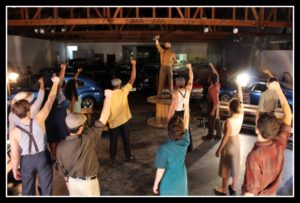 Note: These commentaries are primarily focused on the production, direction, and technical aspects of theater and performing arts.
Note: These commentaries are primarily focused on the production, direction, and technical aspects of theater and performing arts.
Clifford Odets was arguably one of the most skilled playwrights of 1930s American social protest. His writing is spare, almost terse, and highly instructive of the period. His characters are powerful and symbolic without stooping to sentimentality or cliché. And his staging devices are imaginative yet simple without being simplistic. His works have a timelessness so they can be staged in many settings and styles without losing their impact. This production of Waiting for Lefty by the Ubuntu Theater Project (UTP), converts an actual Berkeley, CA, automobile body-and-fender repair shop into a theatre space where directors Emile Whelan and Michael S. Moran present the drama as a series of seven vignettes, separated by blackouts.
If you like your theater understated and enjoy teasing the significance, meaning, or connotation out of this-or-that character’s lines, then Odets is not your playwright, and Waiting for Lefty is not your play. This is politically left, workingman theater delivered with the sweet subtlety of brass knuckles driven by a large muscular man descending from his well-worn, roughly hewn soapbox.
The essence of Waiting for Lefty is that unions and collective bargaining are the only ways for the American workingman to gain any kind of footing against big business. Absent those tools, owners and their cronies can—and will—continually drive down wages and suppress the means necessary for these same workers to do a decent day’s work. As a result, the working classes need to fight like junkyard dogs for their rights, particularly to unionize.
TECHNICAL SCORECARD
Scenic Design:
The choice of the automobile repair shop as a theater was an inspired choice. The hard, stained gray concrete floors; the roughhewn lumber ceiling and supports; parked cars from a variety of decades; garage acoustics; and the smells of rubber, oil, and grease made for a potent backdrop to this production. The setting made the audience feel as if they’d been invited to observe a secret meeting of workingmen to discuss unionization. The set design within the garage was also spare, solid, and simple: a single wooden chair, a large wooden cable spool, and wooden crates. (Score: 9/10)
Set Construction:
The playing area was a rough circle of concrete surrounded by wooden benches and crates for audience seating. In essence the play was presented in the round, with entrances and exits through aisles between the audiences’ seating. No score for this category. (Score: N/A)
Stage Management:
Tight, timely, and effective. JJ Hersh’s efforts were well executed. (Score: 8/10)
Sound:
Acoustics were interesting given that cavernous space, and the number of cars parked just outside the playing area. No score for this category. (Score: N/A)
Props:
Props were appropriate to the message and the set design: spare and simple—a wrench for a gavel; a straight-back, wooden chair; an empty, rough-hewn cable spool acting as a desk; a table; and a podium. The effect, like the play itself, was industrial and hard-edged.
The actors mimed using a camera to take some pictures. We know cameras of that period not by their click but by their flash; even something a subtle as that can cause the audience to lose engagement.
On another note, when an actor hands another actor money, especially when audience members are three or four feet away from the action, real money should be used and the denomination should represent the action. So if an actor is handing someone sixty-five cents, they should hand the actor sixty-five cents and not just a random selection of coins. The same hold true for folding money. While the folding money may not necessarily be period to the production, it detracts from the truth of the show for both audience and actors when obviously fake money is used in a production. Worst of all are those productions that skip the money prop all together and just have the actor mime they are handing another actor money. These are the details that elevate a production above the pedestrian level and crown superior productions. (Score: 7/10).
Costumes:
While the costuming, by Luther Spratt, was close to period for the most part, it was the aspect of the production that was least satisfactory.
- Workingmen’s clothes should look like workingmen’s clothes: wrinkled, sweat stained, maybe soiled.
- One of the male actors was wearing a contemporary watch.
- Shoes on workingmen should not be shined but should show their labor heritage.
- In the SF Bay Area, gaining access to either Goodwill coats for purchase—or even for loan—or access to the costume departments of other theater companies should preclude coats whose sleeves are too short, as occurred on one actor in this production.
- The dress of a working-class housewife whose furniture has just been repossessed should look the part. This actresses’ dress was too upmarket, too fancy. Images like this cause the audience to disengage to one degree or another while they think: That dress isn’t right. Again, with reference to accessibility of costume resources in the Bay Area, no production should trade those audience reality points if at all possible.
- No executive of this period would be caught dead without a tie.
Also, when the cast is singing about not having visibility to their next hot meal, their clothes should map to that message. This material requires that the audience be able to see, simply by looking at the costumes, which are the good guys and which are the bad guys. That message was muddled in this production. (Score: 5.5/10)
Direction:
UTP’s Waiting for Lefty is on the whole competently directed by Emile Whelan and Michael S. Moran.
That said, the acting has a bit of a rushed call-and-response feel—they aren’t talking to each other, just trading lines. The connection between the characters needs work. Also, overall delivery from almost all actors felt to linear and unmodulated.
In addition, the overall timing/pacing of the show felt a bit rushed, which was especially unnecessary given the play’s 45-minute run time. The characters in this play are thinking deep thoughts about complex and potentially dangerous, even life threatening, topics, and their dialog should have the hesitations and pauses such situations command. Even if the playwright didn’t indicate pauses, the material and situation(s) of this play command them.
On another note, when someone writes a brief message to someone, an actor should be directed to make the appropriate amount of effort to actually write the message. (Score: 6.5/10)
Lights:
Stephanie Anne Johnson’s lighting design was simple yet effective: hard, industrial lighting that illuminated the actors clearly if unflinchingly and added stark shadows and sharply-defined profiles, which were not lost on the acting talent. (Score: 7/10)
Casting:
The casting was uniformly good. (Score: 8/10)
Overall Production:
Overall, I liked UTP’s version of Waiting for Lefty, and recommended it as an SFBATCC Go See production. True, as noted here, there are some areas that need fine-tuning. But this is quality material from a playwright who knows his craft, delivered with a level of commitment to quality not always apparent.
Reviewer Score:
Looking at the production as a whole—the text of the play, the messages within it, the energy and craft of the acting team, and the care taken by the creative team—tells the tale: Waiting for Lefty by the Ubuntu Theater Project is a solid production of an important period piece of American history.
Go see it! (Score: 8/10)
Overall Theater Tech Score: (66/90) Good work.
Waiting for Lefty by Clifford Odets
Directed by Emile Whelan and Michael S. Moran at Ubuntu Theater Project. Runs through September 12, 2015 at Classic Cars West, 411 26th St. Oakland CA 94612.
Tickets available online at http://www.ubuntutheaterproject.com
Run time: 45 minutes with no intermission.
Team ASR is composed of a selection of writers, directors, actor, musicians,
Team ASR is composed of a selection of writers, directors, actor, musicians, dancers, technicians, stage managers, and a host of other arts folks.
We don’t name names for obvious reasons — and Team ASR often buys their own tickets and do not announce their presence as such at a performance — but it is important to note that each Team ASR review is screened by one or more ASR Editors to insure a ‘fair’ review, warts and all, when appropriate.
The goal of Team ASR Reviews is to communicate directly with the technical staffs who are largely ignored by most reviewers. These behind the scenes folks work their collective butt’s off to mount a show, and they deserve well-intentioned constructive criticism from fellow artists as appropriate — and ditto for well-earned praise.
***** ***** ***** ***** *****
